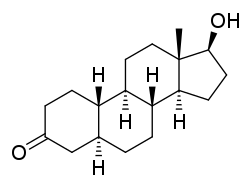5α-Dihydronandrolone
 | |
| Identifiers | |
|---|---|
| |
| Synonyms | Dihydronandrolone; DHN; 5α-DHN; 5α-Dihydro-19-nortestosterone; 5α-Estran-17β-ol-3-one; 19-nor-5α-androstan-17β-ol-3-one |
| CAS Number | |
| PubChem CID | |
| ChemSpider | |
| UNII | |
| ChEMBL | |
| Chemical and physical data | |
| Formula | C18H28O2 |
| Molar mass | 276.42 g/mol |
| 3D model (JSmol) | |
| |
| |
5α-Dihydronandrolone (5α-DHN), or simply as dihydronandrolone (DHN), also known as 5α-dihydro-19-nortestosterone or as 5α-estran-17β-ol-3-one, is a synthetic anabolic-androgenic steroid (AAS) and a 5α-reduced derivative of 19-nortestosterone (nandrolone).[1] It is a major metabolite of nandrolone and is formed from it by the actions of the enzyme 5α-reductase analogously to the formation of dihydrotestosterone (DHT) from testosterone.[1][2]
When testosterone is 5α-reduced into DHT, which is a much more potent AAS in comparison, its effects are potentiated on a local level.[1][2] The tissues in which this occurs (i.e., the tissues that express 5α-reductase) are referred to as "androgenic" tissues and include the skin, hair follicles, and prostate gland, among others.[1] The conversion of testosterone into DHT is an important factor in the etiology of a variety of androgen-dependent conditions, including acne, hirsutism, androgenic alopecia, benign prostatic hyperplasia, and prostate cancer.[1] Unlike the case of testosterone and DHT, 5α-DHN is a much weaker agonist of the androgen receptor (AR) than is nandrolone.[1][2][3][4] For this reason, instead of local potentiation in androgenic tissues, there is a local suppression in AR activation when nandrolone is converted into 5α-DHN by 5α-reductase in these tissues.[1][2][3] This is largely or completely responsible for the exceptionally high ratio of anabolic to androgenic effects seen with nandrolone.[1][2]
The combination of nandrolone with a 5α-reductase inhibitor like finasteride or dutasteride will block the conversion of nandrolone into 5α-DHN and, unlike with testosterone and various other AAS, thereby considerably increase the propensity of nandrolone for producing androgenic side effects.[3]
See also
References
- 1 2 3 4 5 6 7 8 Kicman AT (June 2008). "Pharmacology of anabolic steroids". British Journal of Pharmacology. 154 (3): 502–21. PMID 18500378. doi:10.1038/bjp.2008.165.
- 1 2 3 4 5 John A. Thomas (6 December 2012). Drugs, Athletes, and Physical Performance. Springer Science & Business Media. pp. 29–. ISBN 978-1-4684-5499-4.
- 1 2 3 William Llewellyn (2011). Anabolics. Molecular Nutrition Llc. pp. 464–. ISBN 978-0-9828280-1-4.
- ↑ Bergink EW, Janssen PS, Turpijn EW, van der Vies J (1985). "Comparison of the receptor binding properties of nandrolone and testosterone under in vitro and in vivo conditions". J. Steroid Biochem. 22 (6): 831–6. PMID 4021486.